
Lysmata amboinensis is an omnivorous shrimp species known by several common names including the Pacific cleaner shrimp. It is considered a cleaner shrimp as eating parasites and dead tissue from fish makes up a large part of its diet. The species is a natural part of the coral reef ecosystem and is widespread across the tropics typically living at depths of 5–40 metres (16–131 ft).

Hippolytidae is a family of cleaner shrimp, also known as broken-back shrimp or anemone shrimp. The term "broken-back shrimp" also applies to the genus Hippolyte in particular and "cleaner shrimp" is sometimes applied exclusively to Lysmata amboinensis.

Cleaner shrimp is a common name for a number of swimming decapod crustaceans that clean other organisms of parasites. Most are found in the families Hippolytidae and Palaemonidae, though the families Alpheidae, Pandalidae, and Stenopodidae each contain at least one species of cleaner shrimp. The term "cleaner shrimp" is sometimes used more specifically for the family Hippolytidae and the genus Lysmata.

Ancylomenes magnificus, also known as the magnificent anemone shrimp, is a species of cleaner shrimp common to the Western Pacific Ocean at depths of 3–29 metres (10–95 ft). They are commonly found on stony coral, Catalaphyllia and the sea anemone, Dofleinia armata.

Lysmata wurdemanni, commonly known as the peppermint shrimp, is a species of shrimp.

Farfantepenaeus is a genus of prawns in the family Penaeidae. Its eight species were formerly included in the genus Penaeus. It was first published as a genus name in 1972 by Rudolf N. Burukovsky, but without the necessary designation of a type species. That situation was corrected by the same author in 1997. The name Farfantepenaeus commemorates the Cuban carcinologist Isabel Pérez Farfante.

Lysmata is a genus of shrimp in the infraorder Caridea, the caridean shrimp. The genus belongs to the family Lysmatidae. Lysmata are popular ornamental shrimp in the marine aquarium trade for their bright color patterns, interesting behaviors, and ability to control certain aquarium pests such as sea anemones of the genus Aiptasia. They are known to command high prices on the pet market.
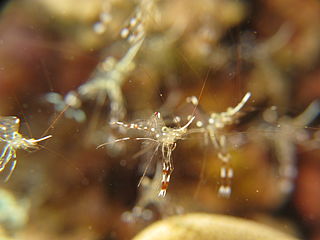
Urocaridella antonbruunii, common names clear cleaner shrimp or red-white cleaner shrimp, is a species of shrimp belonging to the family Palaemonidae. It was described by A. J. Bruce in 1967. It is one of the species that are known as cleaner shrimps.

Ancylomenes pedersoni, sometimes known as Pederson's shrimp and Pederson's cleaner shrimp, is a species of cleaner shrimp. It is part of the genus Ancylomenes and was described in 1958 by Fenner A. Chace Jr. as Periclimenes pedersoni. Ancylomenes pedersoni is found in the Caribbean Sea, often associated with a sea anemone, at depths of 1 to 15 metres. They are often found on the reefs off Bermuda.

Farfantepenaeus aztecus is a species of marine penaeid shrimps found around the east coast of the US and Mexico. They are an important commercial species in the US. The FAO refers to them as the northern brown shrimp; other common names, used in the US, are brown shrimp, golden shrimp, red shrimp or redtail shrimp.
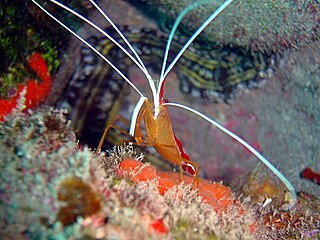
Lysmata grabhami is a species of saltwater shrimp in the family Hippolytidae. It was first described by Gordon in 1935. It occurs in the tropical and subtropical Atlantic Ocean and is a cleaner shrimp, operating a cleaning station to which fish come to have parasites removed.

Lysmata boggessi is a species of saltwater shrimp first classified as Lysmata wurdemanni. It is found in shallow waters of the Atlantic Ocean, and can be distinguished by its coloration pattern.
Lysmata bahia is a species of saltwater shrimp first classified as Lysmata wurdemanni. It is found in shallow waters of the Atlantic Ocean, and can be distinguished by its coloration pattern.

Lysmata pederseni is a species of saltwater shrimp first classified as Lysmata wurdemanni. It is found in shallow waters of the Atlantic Ocean, and can be distinguished by its coloration pattern and its association with tube sponges.
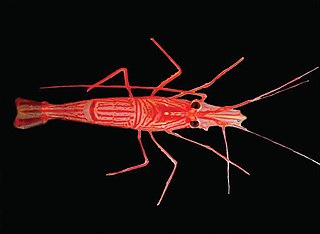
Lysmata ankeri is a species of saltwater shrimp first classified as Lysmata wurdemanni. It is found in shallow waters of the Atlantic Ocean, and can be distinguished by its coloration pattern.

Thoridae, also known as broken-back shrimp or anemone shrimp, is a family of cleaner shrimp.
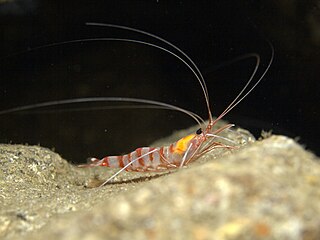
Parhippolyte is a genus of cave dwelling decapod crustaceans, known as cave shrimps from the family Barbouriidae The type species Parhippolyte uveae was described in 1900 by the English carcinologist Lancelot Alexander Borradaile from specimens collected in the south western Pacific by Arthur Willey. As their vernacular name of cave shrimp suggests these species are generally found in marine caves as well as anchialine ponds and lagoons.
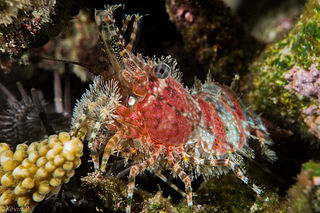
Saron is a small genus of caridean prawns in the cleaner shrimp family Hippolytidae, These are common on the reefs of the Indo-Pacific region and it is possible that there may be many more species yet to be described due to the high variability in colour observed. Some species are kept in the marine aquarium trade.

Saron marmoratus, commonly known as the marbled shrimp, is a species of cleaner shrimp in the family Hippolytidae. It is found in the Indo-Pacific region but in 2013 it was also found off the coast of Lebanon, probably having reached the Mediterranean by Lessepsian migration through the Suez Canal from the Red Sea. It is a popular species in aquaria due to its easy care.

Periclimenes, commonly known as glass shrimp or cleaner shrimp, is a commensal and often symbiotic genus of semi-transparent shrimp within the family Palaemonidae. Species of this large genus feature a wide variety of coloration and patterns, widespread distribution throughout much of the world's tropical oceans, and are often sought out for aquarium trade.


















